| .. | |
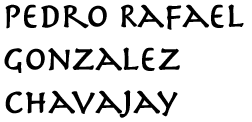 |
|
| . | |
| . | |
| . | |
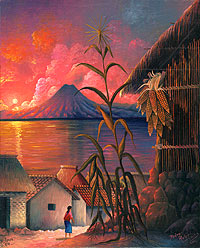 |
|
| . | |
|
LINKS TO SECTION PAGES |
|
| . | |
| Lake Atitlán is a beautiful, idyllic lake in the mountain
highlands of Guatemala. On the north side of the lake the mountains drop off sharply at
the lake. On the far side of the lake are three prominent volcanoes. The classically
shaped Volcano San Pedro stands alone, apart from the other two. At its foot on a shelf
overlooking the lake is the village of San Pedro. The Indian villages on this side of the
lake speak the Mayan dialect Tz'utuhil. San Pedro can be reached by boat, on clear days a
ride of a little more than one hour. Although the lake can now be crossed almost hourly
any day of the week, just a few years ago the boats came and went only two days a week. It was in San Pedro la Laguna in 1929, that Rafael González y González mixed aniline dyes, available for dying the colorful Guatemalan fabrics, with the sap of a local tree in order to paint. Two of Rafael's sons followed in their father's footsteps to become painters. One continues to live in Chicacao, like his father. The other went to live in Guatemala City to be closer to art buyers. The two older sons became albaniles (masons) and returned to San Pedro la Laguna—where they had spent their early childhood—to marry and raise families. The older of the two in turn had a son named Pedro Rafael Gonzalez, who grew up to become the first of the oil painters now living in San Pedro. |
|
| . | |
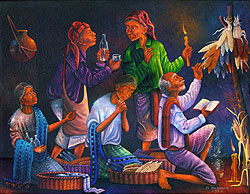 |
|
| . | |
| As a child, Pedro Rafael would accompany his father on trips to visit his grandfather in his plantation home, and was fascinated by watching him bring colors to canvas to create real-life scenes. In grade school young Pedro Rafael distinguished himself in drawing, and he impressed his grandfather by his skill in carrying out drawing assignments. When the boy was in fifth grade his grandfather gave him a set of water colors to practice painting. The following year he made him a gift of oil paints and a brush and showed him how to mount a canvas and to mix colors. In sixth grade, the final year of primary school, Pedro Rafael painted a landscape showing a quetzal in flight with a volcanic peak in the background. A school teacher from Santiago Atitlán who had come to San Pedro to administer year end examinations asked whether the painting was in oils. Assured that it was, he bought it for a $1.50. In 1973 Pedro Rafael, then age 16, had sold his first painting. His grandfather, not Pedro Rafael, was the first person in San Pedro to become a painter, but his grandson was San Pedro's first resident to paint in oils. | |
| . | |
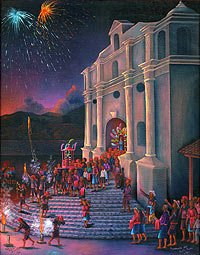 |
|
| . | |
| At age 17 Pedro Rafael went to live for a few years in
Guatemala City with his uncle Jose Antonio, one of the two artist sons of old Rafael
Gonzalez. The two collaborated in turning out pictures for sale. Pedro Rafael, more adept
at drawing than his uncle, did the sketching. José Antonio supplied the motifs and did
most of the coloring. On Sundays they exhibited their wares on the street. One day they
had about thirty paintings on display in front of the Camino Real Hotel on the fashionable
Avenida de la Reforma when along came Ruth Bunge, who was amplifying the stock of
"primitivistic" paintings in her El Sombol gallery across the street from the
hotel. She bought most of the paintings. Her price was low but the quantity offer was
persuasive. She invited the men to bring more paintings to her gallery when they had them.
With the discovery of a steady market, Pedro Rafael decided to go it alone. He returned to
San Pedro, signed his own pictures and in 1979 began selling El Sombol about three
paintings a month, realizing between $10 and $30 apiece, depending on the size. That same year he started to enter painting exhibitions, mostly to compete for prizes rather than to make sales, first in a Sololá gallery, then in Chichicastenango, then in a big exhibit in Guatemala City called "Adios a 79" [Goodbye to 1979]. For a few years in the early 80's, until he found he could get better prices elsewhere, El Sombol was his main outlet. In 1983 he took a job as an instructor of bilingual education. He had no formal education as a teacher and the job pays less than the salary earned by accredited grade school instructors, but he had a growing family to support and felt he could not rely solely on an unpredictable market for works of art. Teachers in Guatemala regularly work five forenoons a week and are on vacation from the end of October until January, and so Pedro Rafael has considerable time to satisfy his urge to paint. Pedro Rafael is distinguished among the painters of San Pedro by the thoughtfulness that pervades all aspects of his work, ranging from the painstaking choice of subject matter to the meticulous application of paint. Other artists may be willing to paint for money but Pedro Rafael says he can't paint unless he feels inspired. He asserts that his small canvases require almost as much mental preparation as the large ones do. He ponders ideas for subjects until he feels the right moment has come. Then at night after others have gone to bed and he can work without interruption, he carefully draws his sketch. For Pedro Rafael the most creative part of the painting process is transforming his mental image into a sketch on canvas. For him the actual painting is nearly automatic. Proceeding slowly, he dabs a spot of paint on the canvas with his brush and spends several minutes working it in before applying the next dab. |
|
| . | |
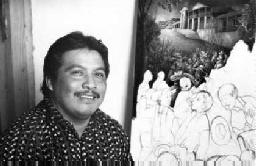 |
|
| . | |
| A sure painter, he clearly has in mind what colors go where and how to mix them. A remarkable feature of his painting is the way he proceeds: starting at an upper corner of the canvas, he paints the painting in virtually its final form as he progresses down to the opposite corner, as though he were unrolling an oriental rug. His paintings are rich in subtle colors but this richness is put into the painting as he proceeds inch by inch, not by subsequent reworking. Overpainting is limited to completing the designs of the woven fabrics worn by the figures or a foreground branch framing the edge of the picture. Some observers claim to see a resemblance to Rembrandt in Pedro Rafael's predilection for dark tones and the artful interplay of light and shadow. | |
| . | |
| . | LINKS TO SECTION PAGES |
|
To contact us write: Arte Maya Tz'utuhil, P.O. Box 40391, San
Francisco, CA 94140. Telephone: (415) 282-7654.
Email me at
All paintings and photographs Copyright © 1988–2015 Arte Maya Tz'utuhil |